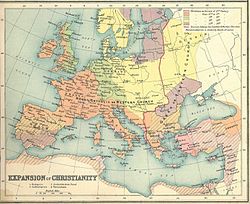Eastern Europe
[1] Narrow definitions, in which Central and Southeast Europe are counted as separate regions, include the countries of Belarus, Russia and Ukraine.[2] In contrast, broader definitions include Moldova and Romania, but also some or all of the Balkans, the Baltic states, the Caucasus, and the Visegrád group.[8] A related United Nations paper adds that "every assessment of spatial identities is essentially a social and cultural construct".[24][25][26][27] The earliest concept of Europe as a cultural sphere (instead of simply a geographic term) was formed by Alcuin of York during the Carolingian Renaissance of the 9th century, limited to the territories that practised Western Christianity at the time.[28] A large section of Eastern Europe is formed by countries with dominant Orthodox churches, like Belarus, Bulgaria, Cyprus, Georgia, Greece, Moldova, Montenegro, North Macedonia, Romania, Russia, Serbia, and Ukraine, for instance, as well as Armenia, which is predominantly Armenian Apostolic.[29][30] Moreover, followers of Eastern Orthodoxy form considerable portions of the populations of predominantly Muslim Albania, Bosnia and Herzegovina, Kazakhstan, and Kosovo, both historically and presently.[41] The fall of the Iron Curtain brought the end of the Cold War east–west division in Europe,[42] but this geopolitical concept is sometimes still used for quick reference by the media.[45] In broadest definition, there are 28 countries that constitute the region of Eastern Europe: Albania, Armenia, Azerbaijan, Belarus, Bosnia and Herzegovina, Bulgaria, Croatia, Cyprus, the Czech Republic, Estonia, Georgia, Greece, Hungary, Kazakhstan, Kosovo, Latvia, Lithuania, Moldova, Montenegro, North Macedonia, Poland, Romania, Russia, Serbia, Slovakia, Slovenia, Turkey, and Ukraine, all of which can be classified into any of the 6 categories below.They are members of the Nordic-Baltic Eight regional cooperation forum whereas Central European countries formed their own alliance called the Visegrád Group.There are two de facto republics with limited recognition in the South Caucasus region that exist under the presence of Russian military.[75] Parts of the Balkans and some more northern areas were ruled by the Achaemenid Persians as well, including Thrace, Paeonia, Macedon, and most of the Black Sea coastal regions of Romania, Ukraine, and Russia.It resembled slavery in terms of lack of freedom, with the distinction that the landowners could not buy and sell serfs separately from the specific plots of land that they were permanently attached to.[88][89] Before 1870, the industrialization that had started to develop in Northwestern and Central Europe and the United States did not extend in any significant way to the rest of the world.New countries included Finland, Estonia, Latvia, Lithuania, Ukraine (which was soon absorbed by the Soviet Union), Czechoslovakia, and Yugoslavia.[92] In some areas, as in the Sudetenland, regions of Poland, and in parts of Slovenia, German speakers constituted the local majority, creating upheaval regarding demands of self-determination.Nearly all became democratic in the 1920s, but all of them (except Czechoslovakia and Finland) gave up democracy during the depression years of the 1930s, in favor of autocratic, strong-man or single-party states.The new states were unable to form stable military alliances, and one by one were too weak to stand up against Nazi Germany or the Soviet Union, which took them over between 1938 and 1945.Russia ended its participation in the First World War in March 1918 and lost territory, as the Baltic countries and Poland became independent.[93] During the final stages of World War II the future of Eastern Europe was decided by the overwhelming power of the Soviet Red Army, as it swept the Germans aside.Throughout Eastern Europe, German-speaking populations were expelled to the reduced borders of Germany (or even Austria) in one of the largest ethnic cleansing operations in history.Many European nations that had been part of the Soviet Union declared or regained their independence (Belarus, Moldova, Ukraine, as well as the Baltic States of Latvia, Lithuania, and Estonia).Many countries of this region joined the European Union, namely Bulgaria, the Czech Republic, Croatia, Estonia, Hungary, Latvia, Lithuania, Poland, Romania, Slovakia and Slovenia.Only three countries are affected by high government debt: Croatia, Hungary and Slovenia (over 70% of the GDP), while Slovakia and Poland fulfill the Maastricht requirement but only 10% below the threshold.[105] The state audit of the government budget and expenditures is an essential control element in public finances and an important part of the concept of checks and balances.As a new phenomenon, a slight negative inflation (deflation) appeared in this decade in several countries (Croatia, Estonia, Hungary, Poland, Romania, Slovakia, and Slovenia), which demonstrates sensitivity regarding international developments.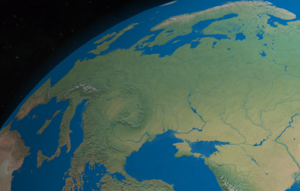
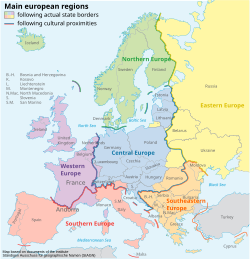
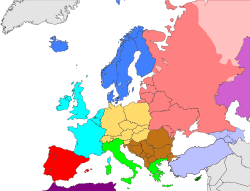
Eastern Europe here is mainly equivalent to the European part of the former
Soviet Union
Northern Europe
Western Europe
Central Europe
Southwest Europe
Southern Europe
Southeast Europe

Northern Europe
Southern Europe
Western Europe

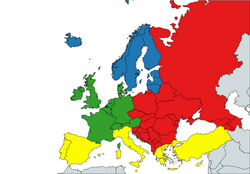
Western Europe
Southern Europe
Northern Europe

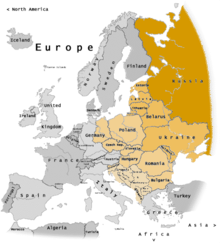
Russia (the former
RSFSR
)
Other countries formerly part of the
USSR
Members of the
Warsaw Pact
Other former Communist states not aligned with Moscow

EuropeEuropean continentUral MountainsCentralSoutheast EuropeBelarusRussiaUkraineMoldovaRomaniaBalkansBaltic statesCaucasusVisegrád groupEuropean cultureEast SlavsGreeksEastern ChristianityEastern Roman EmpireOttoman EmpireCold WarIron Curtaincommunist statesEastern BlocSoviet UnionWestern EuropeCentral and Eastern Europepolitical scientistsgeopoliticalsocioeconomicEnlightenmentUnited Nationscultural constructCIA World FactbookUral RiverCaucasus Mountainsgeographical land borderKazakhstanCentral Asiaculturalgeographical midpoint of EuropeUnited Nations Statistics DivisionEast–West SchismEastern Orthodox ChurchChurch SlavonicCyrillic alphabetAlcuin of YorkCarolingian RenaissanceWestern ChristianityBulgariaCyprusGeorgiaGreeceMontenegroNorth MacedoniaSerbiaArmeniaArmenian ApostolicAlbaniaBosnia and HerzegovinaKosovoSoutheastern EuropeEastern ProtestantismEastern CatholicismCroatiaHungaryLithuaniaPolandSlovakiaSloveniaEastern OrthodoxytheologyUkrainian Greek Catholic ChurchCatholicProtestantEastern Orthodox ChristianWarsaw Pactfall of the Iron CurtaincommuniststatesEuroVocthesaurusPublications Office of the European UnionCentral and Eastern EuropeanAzerbaijanCzech RepublicEstoniaLatviaTurkeyUNESCONational Geographic SocietyCommittee for International Cooperation in National Research in DemographyNorthern EuropeNordic-Baltic EightNorthern Future ForumNordic Investment BankNordic BattlegroupNew Hanseatic LeagueNorthern EuropeanSouth CaucasusdefinitionsEuropean UnionEastern PartnershipEuronest Parliamentary AssemblyCouncil of EuropeEuropean Parliamentrepublics with limited recognitionCommunity for Democracy and Rights of NationsAbkhaziaSouth OssetiaChechen Republic of IchkeriaSecond Chechen WarRepublic of ArtsakhPost-Soviet StatesUnrecognized statesTransnistriaCentral EuropeHoly Roman EmpireHabsburg EmpirePolish–Lithuanian CommonwealthSoutheasternNortheasternSouthern EuropePortugalEast ThraceTurkish Straits
